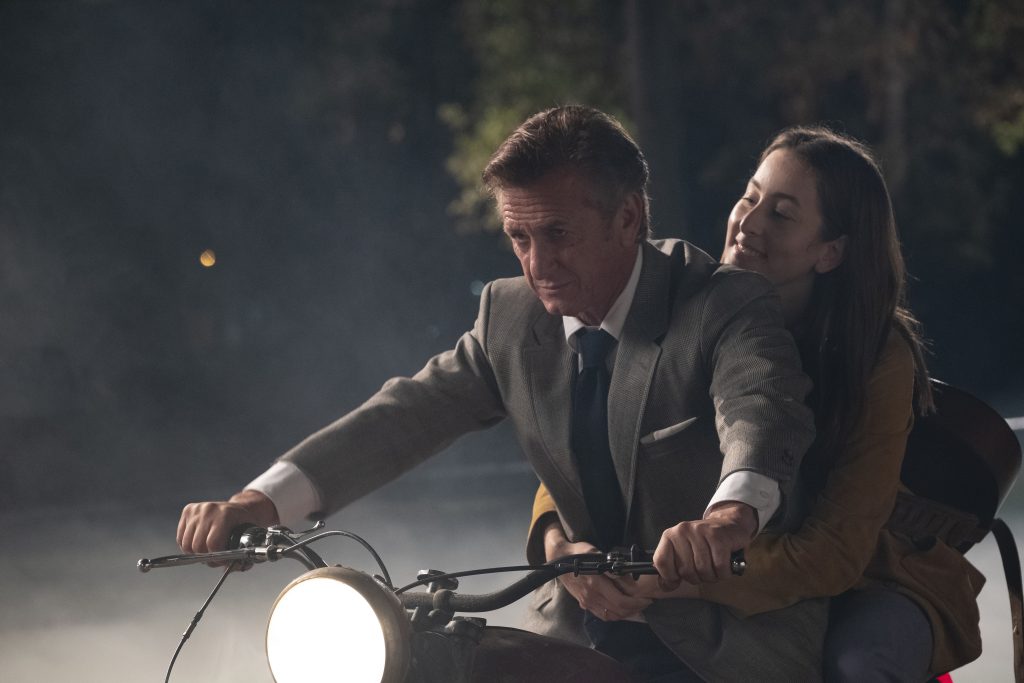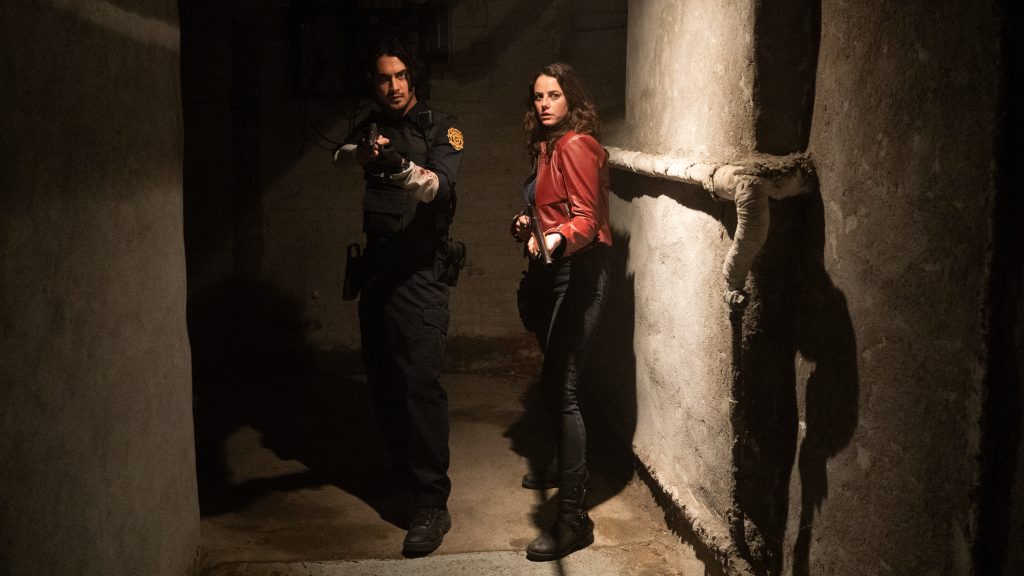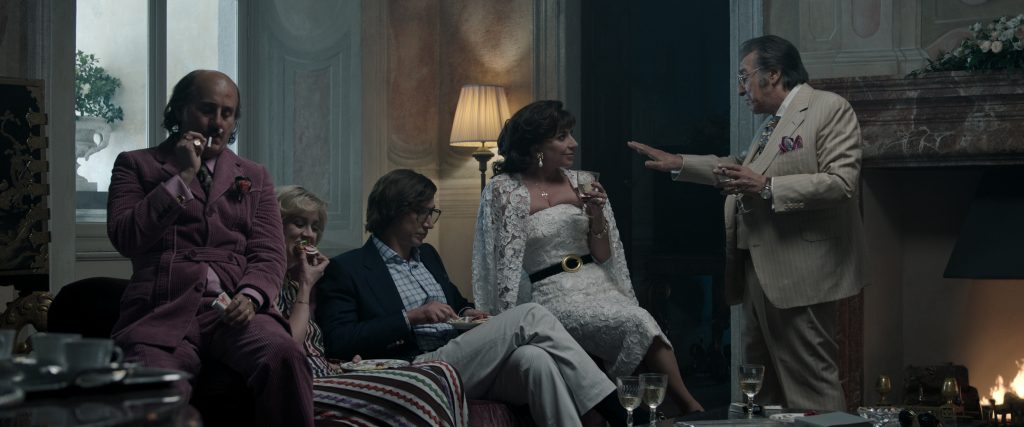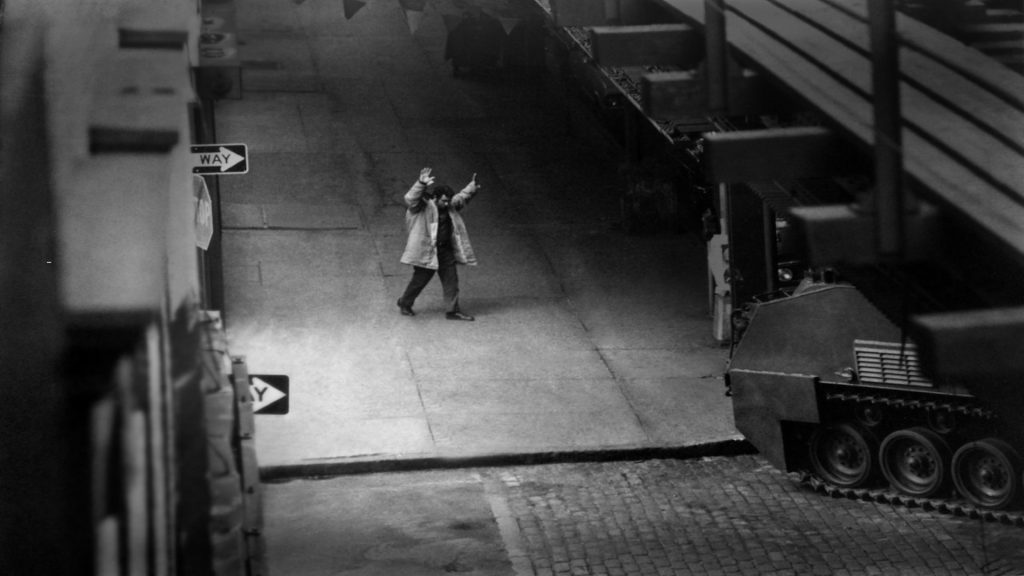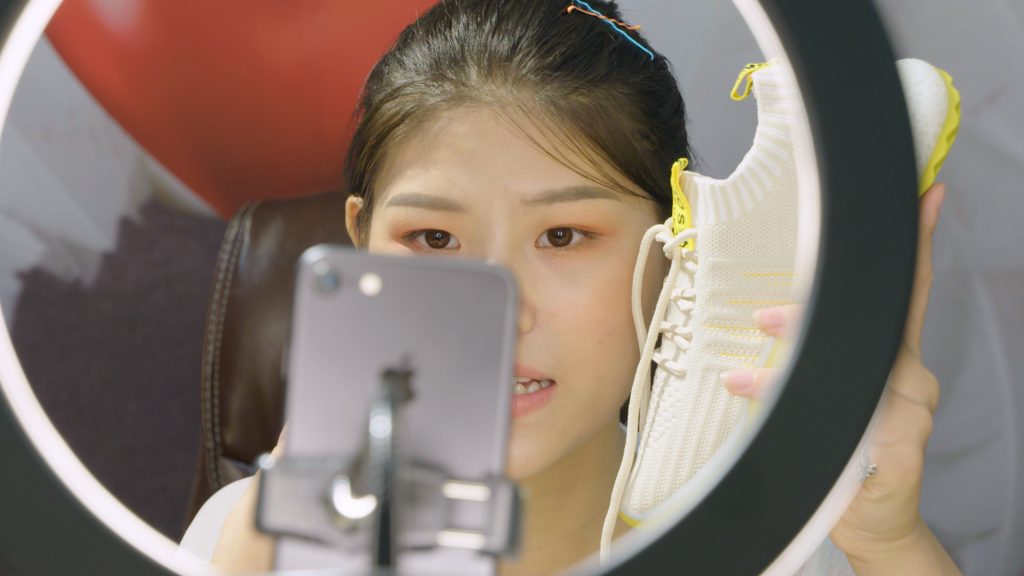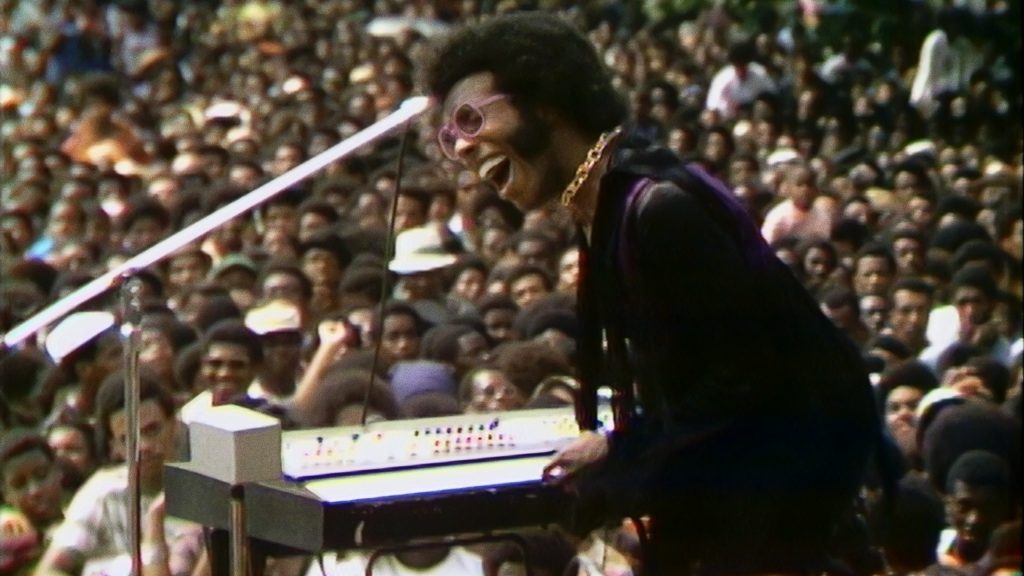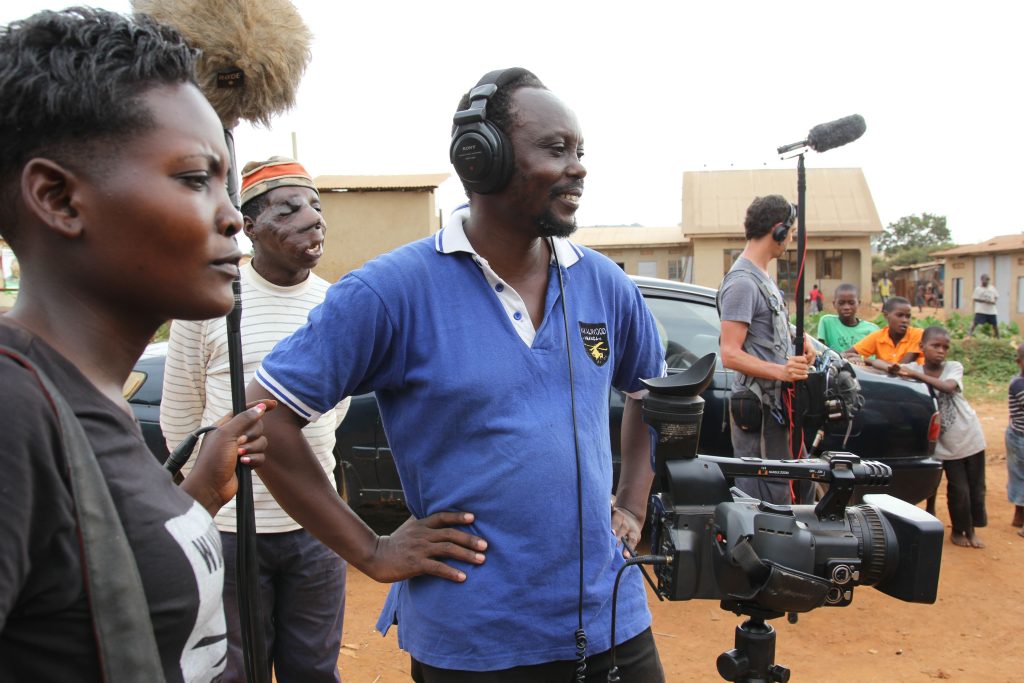November 25, 2021
by Carla Hay

Directed by Peter Jackson
Culture Representation: Taking place in London in January 1969, the three-part documentary series “The Beatles: Get Back” features a predominantly white and mostly British group of people (with one Japanese person and one African American person) representing the middle-class and wealthy in this chronicle of the beginning of the Beatles’ last recording sessions, as well as the Beatles’ last live public performance.
Culture Clash: Before the band broke up in 1970, the Beatles had internal struggles and disagreements over who would lead the band and how each member’s talent and contributions were valued within the group.
Culture Audience: Besides appealing to the obvious target audience of Beatles fans, “The Beatles: Get Back” will appeal primarily to people who are fans of 1960s rock music who want detailed observations of what music studio sessions looked like at the time.
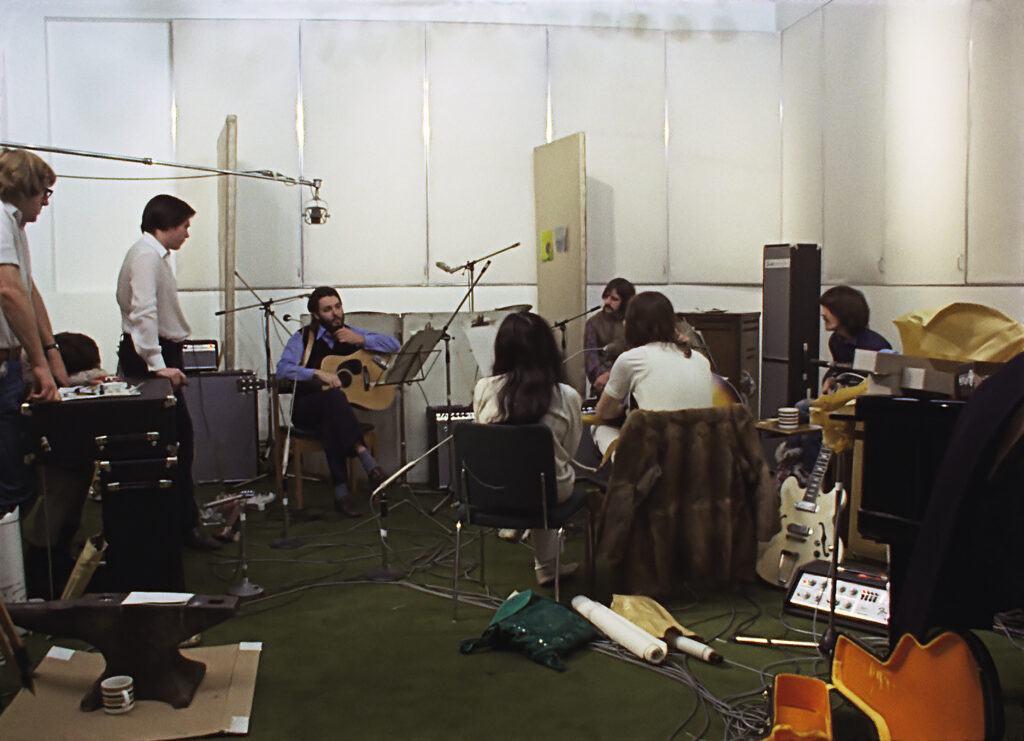
The three-episode official Beatles docuseries “The Beatles: Get Back” gives Beatles fans more than enough of what they might be looking for in this intimate chronicle of the band’s recording sessions and rehearsals in London in January 1969. “The Beatles: Get Back” (directed by Peter Jackson) expands on the footage that was in director Michael Lindsay-Hogg’s 1970 Beatles documentary “Let It Be,” which is no longer officially distributed but has been widely bootlegged. “The Beatles: Get Back” is the docuseries for you, if you’re the type of music fan who relishes seeing several different rehearsal snippets of the same Beatles songs that mostly ended up on the band’s 1969 “Abbey Road” album and 1970 “Let It Be” album. If you have absolutely no interest in watching the Beatles in a recording/rehearsal studio, then you might be bored and might not be able to finish watching this documentary.
That’s because most of the footage in this 468-minute docuseries (that’s 7.8 hours) takes place at recording/rehearsal studios: Twickenham and Apple Corps, to be exact. (Apple Corps is the London-based entertainment company founded by the Beatles in 1967, and is not to be confused with the California-based computer technology company Apple Inc. that was co-founded by Steve Jobs and Steve Wozniak in 1976.) The docuseries culminates with the Beatles performing a brief surprise concert on the rooftop of Apple Corps headquarters, which would end up being the band’s last live public performance. A great deal of the docuseries shows the repetitive nature of doing takes and re-takes of songs in the studio. In that regard, “The Beatles: Let It Be” could have used tighter editing to keep the interest of people with short attention spans.
The vast majority of the docuseries footage is within the confines of a studio. But what happens in that studio is pure magic for people who want to see how the Beatles crafted many of their songs from this period of time. There’s plenty of footage of the band’s personal interactions, but it’s only in the context of this work environment.
And that’s why the docuseries will appeal most to die-hard Beatles fans, who aren’t going to mind that this documentary’s cameras didn’t follow Beatles members Paul McCartney (bass guitar), John Lennon (rhythm guitar), George Harrison (lead guitar) and Ringo Starr (drums) outside of the studio to show what they were like outside of work. People who want to see more controversy in this documentary will be disappointed. However, the filmmakers made the decision not take the tabloid route, so that the documentary would remain focused mainly on the Beatles’ music.
“The Beatles: Get Back” is an insightful look at the band dynamics that foreshadowed why the Beatles broke up in 1970, but the documentary also shows the special chemistry and camaraderie that the Beatles had together. People who know Beatles history are the ones who will have the most appreciation of this deep-dive look into these recording/rehearsal sessions. After all, how many times does someone need to see the different ways that Beatles songs such as “Get Back,” “The Long and Winding Road” or “Don’t Let Me Down” were recorded or rehearsed? Die-hard fans will tolerate this type of repetition the most. The documentary also shows that the Beatles spent a lot of time in the studio performing cover songs for fun.
At the time this documentary footage was filmed, the idea was to record the next Beatles album live in the studio and make a documentary about it. (“Abbey Road” was actually recorded after the “Let It Be” album, but “Abbey Road” was released first.) The band also planned to do a live concert as a TV special. Lindsay-Hogg was the director hired for the documentary and the TV special, with the entire project tentatively called “Get Back,” named after one of the hit songs that would be on the “Let It Be” album. A big problem was that with less than three weeks before the concert was to take place, the band still couldn’t agree/decide on where the concert should be.
In the docuseries, band members have disagreements with each other, but no one has screaming arguments or destroys instruments in anger. Yoko Ono (an avant-garde artist who was Lennon’s girlfriend at the time and became his wife in March 1969) is not seen pitting Lennon and McCartney against each other, and she doesn’t try to tell the band what to do. In other words, this not the Beatles version of the 1984 rock mockumentary “This Is Spinal Tap.” That might come as a surprise to people who have come to expect drama akin to a soap opera in behind-the-scenes music documentaries about rock bands on the verge of splitting up.
And so, people looking for that type of turmoil won’t find it in “The Beatles: Get Back,” whose producers include McCartney, Ono (Lennon’s widow), Olivia Harrison (George Harrison’s widow), Starr and Jackson. The documentary does show how George Harrison briefly quit the Beatles, but his departure is not the disaster it could have been. That’s mainly because the other band members carry on with their work, as if they know deep down that Harrison will change his mind and come back less than a week later. (And that’s exactly what happened.)
Harrison’s temporary split from the Beatles was not made public at the time. This abrupt departure of someone from the most famous band in the world would be harder to keep a secret in today’s celebrity news environment, where this type of news would spread quickly on the Internet. It’s a testament to how the Beatles employees and associates who knew about Harrison quitting back then were discreet enough to not leak this information.
There’s so much to delve into “The Beatles: Get Back” because each episode of the series is longer than the average episode of a docuseries. Episode One is 157 minutes. Episode Two is 173 minutes. Episode Three is 138 minutes. “The Beatles: Get Back” director Jackson (who is a Beatles superfan) and his team lovingly restored the footage that was originally directed by Lindsay-Hogg.
Over the 21 days that Lindsay-Hogg and his team documented the Beatles in January 1969, there were about 60 hours of filmed footage and about 120 hours of audio recordings that ended up being edited for “The Beatles: Get Back” docuseries. The results are footage and audio that look and sound clear and crisp. The songs performed in the studio sessions have quick-cut editing in the docuseries. It’s as if the filmmakers don’t want the entire performance of each song to be seen, in anticipation of the Beatles’ rooftop concert. On-screen captions indicate which takes of these songs ended up on a Beatles album.
It’s explained in the beginning of the series that the Beatles had the daunting task of writing and rehearsing 14 new songs within a two-week period, in order for them to make the deadline for the TV concert. The Beatles didn’t agree on everything, but they all agreed that if this concert was going to happen, it wouldn’t be to play their old hits. They wanted it to be a showcase for their new songs. For recordings and rehearsals, they started off at Twickenham Studios for the first eight days, and then spent the remaining 13 days at Apple Studios.
Here’s a summary of the highlights from each episode:
Episode One
(Days 1 to 7)

The episode begins with a brief chronological history of the Beatles, leading up to January 1969. At this point in the Beatles’ career, the band members were managing themselves, ever since Beatles manager Brian Epstein died of a sedative overdose in 1967, at the age of 32. McCartney is clearly the band member in charge, but disagreements over who should be the band’s next official manager were among the big reasons why the band broke up. Beatles fans will notice in this docuseries that these tensions were brewing and an indication of trouble to come. More on that later.
Even though Epstein wasn’t much older than the Beatles, certain band members still refer to him as “Mr. Epstein” and describe him as a father figure who was the one who kept them disciplined and taught them a certain work ethic as a band. With Epstein gone, McCartney has tried to step into the role of a leader who expects everyone to be their best and show up on time. But it’s how McCartney handles that leadership role that causes friction with other members of the group, especially Harrison and Lennon.
Lennon and McCartney co-wrote most of the songs that ended up on Beatles albums. If McCartney wrote most of a Lennon/McCartney song, McCartney was the one who sang lead vocals. If Lennon wrote most of a Lennon/McCartney song, Lennon was the one who sang lead vocals. Harrison would write Beatles songs on his own and sing lead vocals on them, but his songs were very much in the minority on Beatles albums. On rare occasions, Starr (whose real name is Richard Starkey) got a songwriting credit and lead vocals on a Beatles song.
This is the type of Beatles history that is not explained in the docuseries. However, people who are unfamiliar with the Beatles can discern these group dynamics when watching this docuseries, because every time a song is performed, the song’s title and the last name(s) of the songwriter(s) are listed on the screen. Even people with scarce knowledge of the Beatles have some idea that the Lennon/McCartney songwriting duo was the dominant songwriting partnership in the Beatles.
Although early in the Beatles’ career, Harrison was nicknamed in the media as “The Quiet Beatle,” Starr was actually the quietest member of the Beatles at this point in 1969. He’s often seen silently observing (and sometimes napping) while the other members of the band hash out some of their differences. He’s also the most easygoing member of the Beatles and the one most likely to want to keep the peace. It’s probably why the Beatles chose Starr’s home as the place for the Beatles to meet with Harrison after he abruptly quit the group.
McCartney is either motivational or bossy, depending on your perspective. He’s the one most likely to have big ambitions for the Beatles. He repeats throughout the documentary that he doesn’t just want to do albums. He wants the Beatles’ music to serve a bigger purpose and have more visual documentation of their art, such as filming the recording of the album.
Lennon is the sarcastic joker of the group. After recently getting involved in an intense love affair with Ono, he is shown as becoming less interested in arriving on time for band meetings and studio sessions. Lennon and Harrison are the Beatles members who are most likely to be tardy in these studio sessions.
Ono is never far from Lennon during most of these sessions, where she often sits next to him as if she’s also a member of the band. She doesn’t talk much, but her influence over Lennon is obvious, since she’s the only woman who’s allowed to join in and contribute vocals with the Beatles when they’re writing and recording. She doesn’t sing. The sound that comes out of her mouth is more like screeching or caterwauling.
During the first days of these sessions, Harrison seems motivated and greets people warmly. Harrison and Starr say “Happy New Year” to each other the first time that the band meets for these sessions. In another scene, Harrison compliments McCartney by saying of McCartney’s newly grown facial hair: “I think the beard suits you, man.” But as time goes on, Harrison looks both emotionally alienated and exasperated. And it’s not just because McCartney is telling Harrison how he wants Harrison’s guitar playing to sound.
It’s also because Harrison can see that, once again, most of his song ideas are being ignored. At this point in Harrison’s life, he was deep into Hare Krishna spirituality. It shows in the documentary, because a few of Harrison’s Hare Krishna friends/hangers-on, including two named Shyamsunder Das and Mukanda Goswami, are seen occasionally sitting cross-legged in the background, looking zoned-out or meditative.
For the concert TV special, McCartney was keen for the Beatles to perform a live concert again for the first time in three years (the Beatles quit touring in 1966), but he doesn’t want the band to perform in a typical and predictable setting. It’s here that McCartney tries to assert his leadership because he comes up with the idea that the Beatles should do a surprise concert at a place where they could get arrested. He half-jokingly suggests that the Beatles perform at the House of Parliament, where the band would undoubtedly be ejected. “You have to take a bit of violence,” McCartney says of his idea to do a guerilla-styled concert.
Lindsay-Hogg hates the idea. “I think it’s too dangerous. You could go back to Manila,” he says. It’s a reference to the Beatles’ harrowing 1966 experience of facing a group of angry citizens who aggressively manhandled the Beatles for skipping a meeting with Imelda Marcos, the wife of then-Philippines president Ferdinand Marcos. Lindsay-Hogg is fixated on an idea to have the Beatles perform at an open-air amphitheatre in the desert of Subrata, Libya. (It’s a terrible idea because of the difficult logistics involved. The ancient amphitheatre was not built for a 1969 rock concert that would require a lot of electrical wiring.)
Lindsay-Hogg also suggests that maybe the Beatles could perform at orphanages. He appeals to Harrison’s charitable side by trying to get him to agree to a charity concert. “They say charity begins at home,” Harrison quips. McCartney responds by joking that they should have the concert at Harrison’s house.
Film producer Denis O’Dell pushes for the Beatles to do the concert on some type of ship or boat. However, practical-minded Harrison says that this idea is “insane,” because the acoustics would be substandard and the production costs would be too high. Harrison mentions the Beatles’ widely panned 1967 TV special “Magical Mystery Tour” as an example of an expensive mistake. Lennon doesn’t seem to care where the Beatles play, while Starr says almost nothing at all when it comes to ideas or suggestions.
It’s in this docuseries’ first episode that viewers are also introduced to many of the key crew members who were part of the Beatles’ inner circle for this documentary. There’s Lindsay-Hogg, an American-Irish hotshot director who talks in an upper-crust accent and is often seen puffing on a cigar. He likes to remind people that he’s a huge Beatles fan, not just a hired gun. Far from being a “yes man,” Lindsay-Hogg is very opinionated and isn’t afraid to disagree with some of the Beatles’ ideas.
Beatles music producer George Martin conducts himself with the air of a calm and dignified businessman, but he is surprisingly not in this documentary as much as people might think he would be. Instead, engineer Glyn Johns (who is most definitely not a businessman type) has the most screen time as the one who takes charge of the technical side of the recording sessions. Other staffers and associates who are seen in the documentary, beginning with this episode, include Apple president Neil Aspinall, music publisher Dick James, roadie/personal assistant Mal Evans, roadie Kevin Harrington, cinematographer Tony Richmond, camera operator Les Parrott, song recordist Peter Sutton and electronic engineer Alexis “Magic Alex” Mardas.
Harrison is the first one the documentary to mention that the Beatles should break up. “Maybe we should have a divorce,” Harrison tells the other Beatles. Lennon quips, “Who would have the children?” McCartney jokes, “Dick James.” McCartney’s comment refers to how, at the time, James (through his Northern Songs Ltd. publishing company) owned the copyrights to Beatles songs written by Lennon and McCartney. Later in 1969, James sold Northern Songs to Associated Television (ATV) without telling Lennon and McCartney in advance. The battle to own the Beatles’ song publishing could be its own documentary.
Starr’s wife Maureen Starkey makes a brief appearance. Just like the other women in this documentary, she doesn’t say much. The episode ends with Harrison getting up and announcing he’s leaving the band. Lennon says that if Harrison doesn’t come back in a few days, the Beatles should get Eric Clapton as a replacement. (Clapton was Harrison’s best friend at the time.) An episode epilogue caption says that the attempted reconciliation with Harrison at Starr’s house did not go very well.
What the documentary doesn’t mention is that Starr’s wife Maureen Starkey and Harrison were having an affair at the time, according to several books about the Beatles. Meanwhile, Clapton was in love with Harrison’s wife Pattie (Clapton wrote the 1971 song “Layla” about her), and she would eventually leave Harrison in 1977 for Clapton, who became her second husband two years later. If this is the type of love triangle drama that people wanted to see in this documentary, you’re not going to find it.
Episode Two
(Days 8 to 16)

As we all know, Harrison eventually did come back to the Beatles, as seen in this episode. During his absence, the other band members have a bittersweet laugh when a bouquet of flowers arrives for Harrison at the studio. Starr opens the greeting card and sees that the flowers are from a Hare Krishna group that obviously doesn’t know that Harrison had recently quit the band.
But the most intriguing part of the episode is that McCartney starts to get real about the band’s problems. The documentary mentions that a hidden microphone was placed in a flower pot to capture a conversation between Lennon and McCartney over Harrison’s unhappiness in the Beatles. This secret recording was clearly the filmmakers’ attempt to find out McCartney’s true feelings, since he was the band member who tended to be the most image-conscious and careful about what he said on camera.
In this undercover conversation, Lennon says of Harrison’s discontent: “It’s a festering wound that we’ve allowed … and we didn’t give him any bandages. We have egos.” McCartney says of Harrison’s concerns: “I do think he’s right.” McCartney also tries to appeal to Lennon’s ego by saying that the Beatles will always be Lennon’s band.
Through his actions and words in this documentary, McCartney seems to want to give the impression that he’s stepping up in a leadership role because no one else in the Beatles wants to do it. The problem, which has also been documented in several books about the Beatles, is that the other members of the group get frustrated when McCartney acts like his ideas are usually the best ideas. Harrison isn’t the only one who’s starting to drift away and feel alienated.
In another part of the episode, when McCartney knows that he’s being filmed, he says to a group of people (including Eastman and Starr) that Lennon is losing interest in the Beatles. If Lennon had to choose between the Beatles or Ono, McCartney predicts: “Obviously, if it came to a push between Yoko and the Beatles, it’s Yoko.” McCartney also says that he and Lennon are spending less time writing songs together because their lifestyles have changed. He mentions that because the Beatles weren’t touring, he and Lennon weren’t spending time together in hotel rooms, where Lennon and McCartney would get a lot of songwriting done.
New romances were affecting the Lennon/McCartney friendship. Linda Eastman, a photographer from New York, had recently begun dating McCartney and would become his wife in March 1969. Eastman is in the documentary as a laid-back presence, who occasionally takes photos and snuggles with McCartney. During a band meeting where they discuss Harrison quitting the group, Eastman pipes up that she noticed that at the reconciliation attempt at Starr’s house, Ono seemed to be talking for Lennon instead of Lennon talking for himself.
The documentary doesn’t give a lot of evidence to support a lingering perception among some Beatles fans that Ono is mainly to blame for breaking up the Beatles. She doesn’t talk much when she’s with the Beatles in these studio sessions. On the rare occasions that she smiles, it’s when she gazes lovingly at Lennon or shows other public displays of affection with him. She’s shown as not being particularly close to anyone in the Beatles’ inner circle except for Lennon. McCartney says prophetically, “It’s going to be such an incredible, comical thing, like in 50 years’ time [people will say], ‘They broke up because Yoko sat on an amp.'”
Still, there’s no denying that there’s unspoken tension between McCartney and Ono. During a group discussion, McCartney talks about how he still wants the Beatles to be on the top of their game in the documentary. “We want to show the world what we have,” McCartney says. Ono chimes in, “Or what we haven’t.”
The reality seems to be sinking in with McCartney that he and his longtime pal Lennon are going in different directions with their lives. McCartney seems to want to hold on to an idea that the Beatles can continue, but only if they agree with his wish that they don’t do anything in a boring and predictable way. Meanwhile, a frustrated Harrison seems like he wants to be a solo artist, whether the other band members approve or not. As for Starr, he just seems to want to know if he has a job and where to show up. When McCartney half-jokingly suggests that the Beatles should announce their breakup at the end of their upcoming concert, Starr reacts with a mortified look on his face that’s priceless.
In between all of this interpersonal drama, the Beatles are still capable of working together in a respectful and cohesive manner as musicians in a studio. Harrison starts to become more jovial, while Lennon cracks jokes to lighten the mood. After Harrison comes back to the band, McCartney seems more mindful of how he gives suggestions to Harrison, in order to avoid looking like an overly critical taskmaster.
McCartney also mentions to his bandmates that he has personal film footage of the time that the Beatles spent at a 1967 retreat with the spiritual guru Maharishi Mahesh Yogi, who was exposed years later as a con artist. McCartney vividly describes scenes from this footage, some of which are shown in the documentary. Lennon and McCartney have a laugh when McCartney comments on the retreat, “You can see from the film that it’s very much like school.”
Harrison’s wife Pattie appears very briefly in this episode when she visits the studio. Out of all of the Beatles’ significant others at the time, she’s the one who is seen the least in the documentary. Pattie was busy with her modeling career at the time, but she and other people have since revealed that her marriage to Harrison was in deep trouble in 1969, because of the love triangle with Clapton.
A great scene in this episode is when comedian/actor Peter Sellers (who was Starr’s co-star in the 1969 movie “The Magic Christian”) stops by for a visit. It’s the first time that Sellers has met the members of the band, other than Starr. Sellers is quiet and bashful. Some viewers might speculate that he seems a little star-struck by the Beatles. He also seems a little bored, because he doesn’t stay for long. Maybe he thought being in a recording studio with the Beatles would be one big party.
In this encounter with Sellers, Lennon proves to be a lot funnier than world-famous comedian Sellers. As Sellers says a “nice to meet you” goodbye to the group, Lennon makes a drug joke when he says to Sellers: “Just don’t leave the needles lying around.” Everyone in the room laughs, except for Sellers, who seems a little taken aback by this joke and that someone can get bigger laughs than he usually does.
Speaking of drug references, there are some noticeable ones in this episode. Lennon shows up late at the studio one day, and he says it’s because he stayed up all night while he was on drugs. “I was stoned and high and watching films,” Lennon confesses. McCartney, ever aware of the Beatles’ image, looks slightly alarmed, knowing that Lennon was caught on camera with this comment. McCartney responds, “Is there a need to do this in public, Mr. Lennon?”
Earlier in the episode, Starr is seen on camera asking personal assistant Evans, “Do you have any pep pills?” And the band’s goofiest antics and loopiest comments in this episode and the other episodes in the docuseries could be interpreted as actions of people under the influence of unnamed substances. At any rate, no one actually says out loud which illegal drugs might have been consumed. The Beatles are seen smoking a lot of cigarettes and drinking alcohol (usually wine or beer) during these sessions. Even if illegal drug taking had been caught on camera, it wouldn’t have made the final cut in a Disney+ documentary.
This episode shows how image-conscious the Beatles were, since there are multiple scenes of them reading articles about themselves in newspapers and magazines and making comments about what they see in this media coverage. Harrison is irked by a Daily Mail article written by Michael Housegro, in which Housegro claims that Lennon and Harrison got into a fist fight and that the Beatles are on the verge of breaking up.
Housegro was wrong about the fist fight, and Harrison asks someone in the room if the Beatles can sue over the article. The answer is no. Harrison and Lennon have a bit of a laugh over it though, and pretend to get in a fist fight when the article is read out loud. Later, McCartney reads the article out loud in a very sing-song, sarcastic manner while plugged into a microphone and pretending that article’s words are lyrics to a song.
The Beatles move their recording/rehearsal sessions to Apple when their scheduled time at Twickenham comes to an end. When they begin working at Apple, it’s the first time that the documentary shows life outside the studio bubble. The members of the band show up in separate cars and walk inside without any bodyguards or entourages. If there were any paparazzi photographers lurking about, they’re not shown in this documentary.
It’s in this episode that Apple Scruffs (the nickname for the female fans who would wait outside Apple headquarters to get a glimpse of the Beatles) are first seen. Two Apple Scruffs named Eileen Kensles and Sue Ahearne are interviewed. They both say that what they want most for the Beatles to do next is to perform a live concert.
At Apple headquarters, Magic Alex had constructed a custom-built studio for the Beatles. However, the band discovers that this custom studio equipment has too much distortion. Beatles producer Martin comes to the rescue by letting the Beatles use some equipment that he had, thereby diverting a major setback.
Things get livelier when keyboardist Billy Preston joins the sessions. His enthusiasm and talent seem to lift the Beatles’ spirits. McCartney briefly considers eventually making Preston a permanent member of the Beatles, but McCartney ends up nixing the idea. “It’s bad enough with four [members of the band],” McCartney comments.
And if you didn’t already know that “Get Back” was originally going to be a protest song against white nationalism, anti-immigrant racism and xenophobia, then you’ll find out what were some of the lyrics that McCartney originally wanted for the song. “Get Back” eventually evolved into a non-political song, but it’s interesting to see the thought process that went into the crafting of this song. At this point in his career, McCartney avoided making overt political statements in his songs, so his original intention for “Get Back” would have been a major departure for him.
Another song that went through a metamorphosis was Lennon’s “The Road to Marrakesh.” Never heard of it? That’s because the docuseries shows in this episode that “The Road to Marrakesh” was an early version of “Jealous Guy,” a song that would end up on Lennon’s 1971 solo album “Imagine.” The song’s melodies essentially remained the same, but the lyrics became very different when the song morphed into “Jealous Guy.”
Making brief appearances in this episode are photographer Ethan Russell (the cover of the “Let It Be” album features his photos), Apple executive Peter Brown and art dealer Robert Fraser. Brown and author Steven Gaines would later write the unauthorized Beatles tell-all book “The Love You Make: An Insider Story of the Beatles,” which was published in 1983. It’s considered one of the first exposés of the Beatles in-fighting that went on behind the scenes.
Lindsay-Hogg was also the director of the concert TV special “The Rolling Stones Rock and Roll Circus,” which featured Lennon and Ono among the guest performers. Lindsay-Hogg is seen asking Lennon if he wants to be a guest on this TV special, and Lennon readily agrees. It’s because of “The Rolling Stones Rock and Roll Circus” that Lennon came into contact with Allen Klein, who was the Rolling Stones’ manager at the time.
Klein was a controversial figure in the histories of the Rolling Stones and the Beatles. By all accounts, he desperately wanted to manage the Beatles. Klein does not make an appearance in “The Beatles: Get Back” docuseries, but it clearly shows through Lennon’s descriptions of Klein how Klein began to woo and charm his way into the Beatles’ lives.
In this episode, the idea to have a live TV concert is scrapped. And it comes as no surprise, because the band was never ready to do a live TV show with just two weeks of preparation. However, McCartney still wants the Beatles to perform their new songs live somewhere and having it filmed. Lindsay-Hogg and Johns suggest doing a surprise show without a permit on the rooftop of Apple Corps, thereby making McCartney’s idea to have a guerilla-styled Beatles concert become a reality.
Episode Three
(Days 17 to 21)
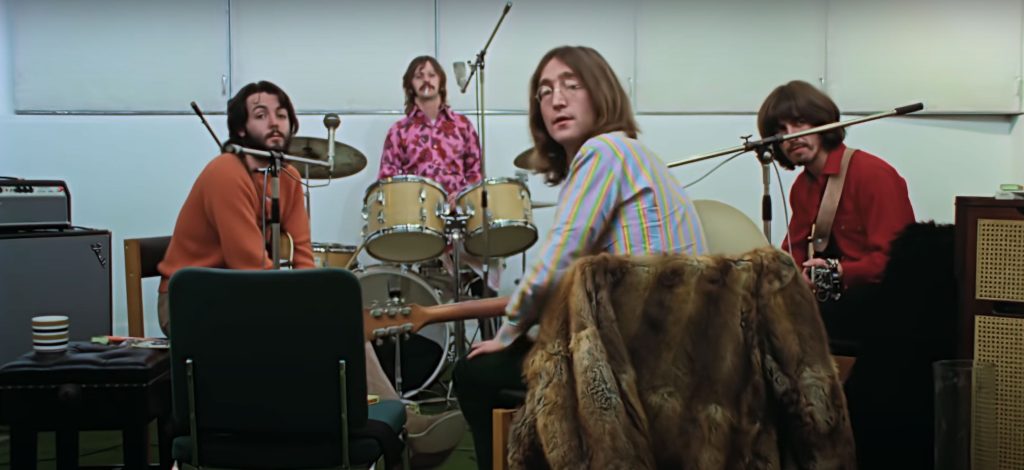
Considering the internal problems that the Beatles were experiencing at the time, you would think that this strife would get worse as this docuseries goes on. In fact, this last episode is the most light-hearted of the three. One of the main reasons why it has so many laugh-out-loud moments is because of how it shows people’s various reactions to the Beatles’ surprise rooftop concert. The Beatles also seem more relaxed with each other, compared to previous days of the sessions.
During the rooftop concert, people are interviewed on the street by members of the film crew. Reactions are mostly positive. One middle-aged man says of the free concert: “It’s nice to have something for free in this country at the moment.”
Meanwhile, the complainers look like out-of-touch grouches in retrospect. One young man snarls angrily that the roof is “a bloody stupid place to have a concert.” An elderly woman is infuriated when she comments on the Beatles doing a free show on a rooftop: “I don’t see how it makes sense! It woke me up from my sleep, and I don’t like it!”
There’s also a very Keystone Kops moment when two young police officers are the first cops to respond to the noise complaints caused by the concert. One of the cops wants to take charge, but it’s obvious that he’s reluctant to arrest anyone in the Beatles. He does a lot of huffing and puffing and says this empty threat: “We’ve got 30 complaints within minutes … Turn it [the volume] down, or I’m going to have to start arresting people!” Meanwhile, the agitated cop’s partner barely says a word. You can tell that these reactions were not scripted, which makes everything even more hilarious.
Earlier in this episode, Eastman’s then-6-year-old daughter Heather (from Eastman’s first marriage) is shown being an adorable and happy kid in the studio. She brings a lot of joy to the people around her. McCartney treats her like a doting father (he bounces her up in the air and hugs her a lot), while the other Beatles (especially Lennon and Starr) are friendly and attentive to Heather. She’s talkative, curious, and is allowed to run around and play in the studio. When Heather sees Ono shrieking in a microphone, Heather starts to do that too. Lennon reponds to Heather’s vocal imitations by saying jokingly: “Yoko!”
Heather isn’t the only one acting goofy in the studio. A scene in this episode shows Starr, McCartney, Martin and Lindsay-Hogg appearing to have a serious conversation. Suddenly, Starr blurts out: “I’ve farted. I thought I’d let you know.”
Some Beatles associates featured in this episode include tape operator (and future artist/producer) Alan Parsons, sound engineer Keith Slaughter, Apple press officer Sally Burgess, producer/engineer Chris Thomas, Paul McCartney’s younger brother Mike McCartney, Apple office doorman Jimmy Clark and Apple office receptionist Debbie Wellum. When the cops show up during the Beatles’ rooftop concert, Wellum does a brilliant job of acting ignorant in stalling the cops as long as possible from going up to the roof.
But problems in the Beatles remain. While planning the rooftop concert, Paul McCartney is enthusiastic about it, while Harrison says irritably: “I don’t want to go on the roof.” Starr and Lennon chime in and both say consecutively: “I would like to go on the roof.” And with those statements, Harrison is outnumbered, and he seems to stop complaining about having to do this rooftop concert. However, Harrison still voices his dislike of the idea that the Beatles should continue to do films. It’s the opposite of how McCartney feels.
At this point in the Beatles’ history, Harrison is openly discussing taking his rejected Beatles songs and making a solo album out of it. He talks about it with Lennon and Ono, who tells Harrison that she thinks the solo album is a good idea. Meanwhile, Harrison is seen helping Starr come up with some ideas to finish Starr’s song “Octopus’s Garden,” which ended up on the “Abbey Road” album. It’s an example of how underrated Harrison was as a songwriter for the Beatles, because Starr (under his real name, Richard Starkey) is the only credited songwriter for “Octopus’s Garden.” This documentary clearly shows that Harrison co-wrote the song.
In this episode, Harrison talks about trying to finish a song that would become one of his most beloved ballads: “Something,” an “Abbey Road” hit single that was inspired by his then-wife Pattie. The first line of the song ended up being: “Something in the way she moves attracts me like no other lover.” But the documentary shows that Harrison had difficulty coming up with that first line.
Harrison considered using the phrase “attracts me like a Cadillac” or “attracts me like a pomegranate.” Lennon advises Harrison to just write what naturally comes to mind. “The Beatles: Get Back” is superb when it has this type of camaradie moment that shows a glimpse into how a classic Beatles song was written.
Lennon is in mostly a good mood during these final days of filming the documentary. He announces jubilantly that Ono’s divorce from her second husband Anthony “Tony” Cox has become final. (Lennon had already offically divorced his first wife Cynthia in November 1968.) Lennon is also seen praising Klein.
“I think he’s fantastic!” Lennon gushes to Harrison about Klein. “He knows everything about everything! He knows what we’re like. He knows me as well as you do!” The Beatles and the Rolling Stones were both signed to EMI Records at the time. Lennon also says he’s impressed that Klein was able to get an EMI royalty rate for the Rolling Stones that’s higher than the Beatles’ royalty rate, so Lennon wants Klein to do the same for the Beatles.
The Beatles have ther first meeting with Klein in this episode, but the meeting was not filmed for the documentary. In a voiceover, Johns is heard expressing cautious skepticism about Klein: “He’s a strange man, but very, very clever.” Johns also describes Klein’s habit of abruptly changing the subject in a conversation if someone says something that Klein doesn’t want to hear. “That bugs me a bit, actually,” adds Johns of Klein’s rudeness.
Harrison and Starr seem noncommittal about Klein at this point. However, people who watch this documentary should observe the expression on McCartney’s face when Klein’s name is mentioned by Lennon. Beatles fans now know that McCartney had already been planning to have Linda Eastman’s attorney father Lee Eastman take over management duties for the Beatles. McCartney is clearly concerned (and probably annoyed) that Lennon could persuade the other members of the band to want to hire Klein as the manager of the Beatles.
It’s a red flag of the management disagreements that would end up being a huge part of the Beatles’ breakup. But the docuseries ends in the best possible way, by showing the rooftop concert that would be the last time that the Beatles would ever perform together in public. (All of the Beatles’ wives/girlfriends are there except for Harrison’s.)
For the rooftop concert, the documentary shows the band performing “Get Back” (twice, but not consecutively), “Don’t Let Me Down” (twice, but not consecutively), “One After 909,” “Dig a Pony” and “I’ve Got a Feeling.” All these years later, the Beatles are still considered by many people to be the greatest rock band of all time. “The Beatles: Get Back” is a densely layered exploration into their artistic side, but it admirably never loses sight of the Beatles’ human side.

Here are the songs that are featured in “The Beatles Get Back” docuseries:
Beatles-Written Songs (for the Beatles or for Solo Material) Performed as Excerpts
In alphabetical order:
- “Across the Universe”
- “All Things Must Pass”
- “Another Day”
- “The Back Seat of My Car”
- “Because I Know You Love Me So”
- “Bonding”
- “Carry That Weight”
- “Castle of the King of the Birds”
- “Commonwealth”
- “Dehra Dun”
- “Dig a Pony”
- “Dig It”
- “Don’t Let Me Down”
- “Every Little Thing”
- “Fancy My Chances With You”
- “For You Blue”
- “Get Back”
- “Gimme Some Truth”
- “Golden Slumbers”
- “Half a Pound of Greasepaint”
- “Help”
- “Her Majesty”
- “I Bought a Piano the Other Day”
- “I Lost My Little Girl”
- “I Me Mine”
- “I’m So Tired”
- “Isn’t It a Pity”
- “I Told You Before”
- “I’ve Got a Feeling”
- “I Want You (She’s So Heavy)”
- “Just Fun”
- “Let It Be”
- “The Long and Winding Road”
- “Love Me Do”
- “Madmen”
- “Martha My Dear”
- “Maxwell’s Silver Hammer”
- “Mean Mr. Mustard”
- “My Imagination”
- “Ob-La-Di, Ob-La-Da”
- “Octopus’s Garden”
- “Oh! Darling”
- “Old Brown Shoe”
- “One After 909”
- “On the Road to Marrakesh” (which later became “Jealous Guy”)
- “Please Please Me”
- “Polythene Pam”
- “She Came in Through the Bathroom Window”
- “Song of Love”
- “Strawberry Fields Forever”
- “Suzy Parker”
- “Teddy Boy”
- “Too Bad About Sorrow”
- “Two of Us”
- “What Do You Want to Make Those Eyes at Me For?”
- “Within You, Without You”
- “You Wear Your Women Out”
Cover Songs Performed as Excerpts
In alphabetical order:
- “Act Naturally”
- “Blue Suede Shoes”
- “Bye Bye Love”
- “Gilly Gilly Ossenfeffer”
- “Going Up the Country”
- “Hallelujah I Love Her So”
- “Hi-Heel Sneakers”
- “Honey Hush”
- “House of the Rising Sun”
- “Johnny B. Goode”
- “Kansas City”
- “The Midnight Special”
- “The Mighty Quinn”
- “Miss Ann”
- “New Orleans”
- “Queen of the Hop”
- “Rock and Roll Music”
- “Save the Last Dance for Me”
- “School Days”
- “Shake, Rattle and Roll”
- “Stand By Me”
- “Take These Chains From My Heart”
- “Twenty Flight Rock”
Disney+ premieres each of the three episodes of “The Beatles: Get Back” on November 25, November 26 and November 27, 2021.
UPDATE: Walt Disney Pictures will release the feature film “The Beatles: Get Back—The Rooftop Concert” as an exclusive IMAX event screening with a filmmaker Q&A on January 30, 2022. “The Beatles: Get Back—The Rooftop Concert” will then have a global theatrical engagement from February 11 to February 13, 2022. The complete docuseries “The Beatles: Get Back” will be released on Blu-ray and DVD on February 8, 2022.


